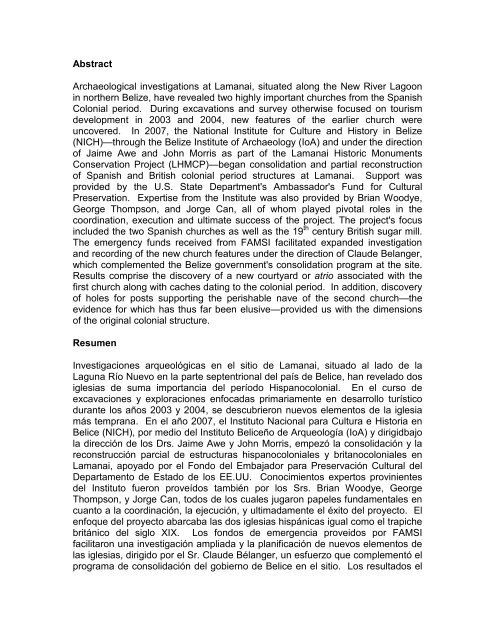Report submitted to FAMSI:
Report submitted to FAMSI:
Report submitted to FAMSI:
You also want an ePaper? Increase the reach of your titles
YUMPU automatically turns print PDFs into web optimized ePapers that Google loves.
Abstract<br />
Archaeological investigations at Lamanai, situated along the New River Lagoon<br />
in northern Belize, have revealed two highly important churches from the Spanish<br />
Colonial period. During excavations and survey otherwise focused on <strong>to</strong>urism<br />
development in 2003 and 2004, new features of the earlier church were<br />
uncovered. In 2007, the National Institute for Culture and His<strong>to</strong>ry in Belize<br />
(NICH)—through the Belize Institute of Archaeology (IoA) and under the direction<br />
of Jaime Awe and John Morris as part of the Lamanai His<strong>to</strong>ric Monuments<br />
Conservation Project (LHMCP)—began consolidation and partial reconstruction<br />
of Spanish and British colonial period structures at Lamanai. Support was<br />
provided by the U.S. State Department's Ambassador's Fund for Cultural<br />
Preservation. Expertise from the Institute was also provided by Brian Woodye,<br />
George Thompson, and Jorge Can, all of whom played pivotal roles in the<br />
coordination, execution and ultimate success of the project. The project's focus<br />
included the two Spanish churches as well as the 19 th century British sugar mill.<br />
The emergency funds received from <strong>FAMSI</strong> facilitated expanded investigation<br />
and recording of the new church features under the direction of Claude Belanger,<br />
which complemented the Belize government's consolidation program at the site.<br />
Results comprise the discovery of a new courtyard or atrio associated with the<br />
first church along with caches dating <strong>to</strong> the colonial period. In addition, discovery<br />
of holes for posts supporting the perishable nave of the second church—the<br />
evidence for which has thus far been elusive—provided us with the dimensions<br />
of the original colonial structure.<br />
Resumen<br />
Investigaciones arqueológicas en el sitio de Lamanai, situado al lado de la<br />
Laguna Río Nuevo en la parte septentrional del país de Belice, han revelado dos<br />
iglesias de suma importancia del período Hispanocolonial. En el curso de<br />
excavaciones y exploraciones enfocadas primariamente en desarrollo turístico<br />
durante los años 2003 y 2004, se descubrieron nuevos elemen<strong>to</strong>s de la iglesia<br />
más temprana. En el año 2007, el Institu<strong>to</strong> Nacional para Cultura e His<strong>to</strong>ria en<br />
Belice (NICH), por medio del Institu<strong>to</strong> Beliceño de Arqueología (IoA) y dirigidbajo<br />
la dirección de los Drs. Jaime Awe y John Morris, empezó la consolidación y la<br />
reconstrucción parcial de estructuras hispanocoloniales y britanocoloniales en<br />
Lamanai, apoyado por el Fondo del Embajador para Preservación Cultural del<br />
Departamen<strong>to</strong> de Estado de los EE.UU. Conocimien<strong>to</strong>s exper<strong>to</strong>s provinientes<br />
del Institu<strong>to</strong> fueron proveídos también por los Srs. Brian Woodye, George<br />
Thompson, y Jorge Can, <strong>to</strong>dos de los cuales jugaron papeles fundamentales en<br />
cuan<strong>to</strong> a la coordinación, la ejecución, y ultimadamente el éxi<strong>to</strong> del proyec<strong>to</strong>. El<br />
enfoque del proyec<strong>to</strong> abarcaba las dos iglesias hispánicas igual como el trapiche<br />
británico del siglo XIX. Los fondos de emergencia proveidos por <strong>FAMSI</strong><br />
facilitaron una investigación ampliada y la planificación de nuevos elemen<strong>to</strong>s de<br />
las iglesias, dirigido por el Sr. Claude Bélanger, un esfuerzo que complementó el<br />
programa de consolidación del gobierno de Belice en el sitio. Los resultados el
















